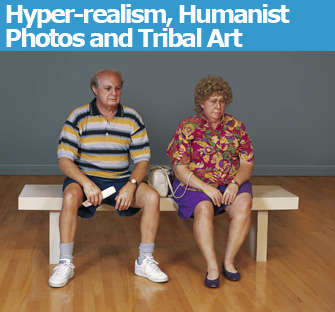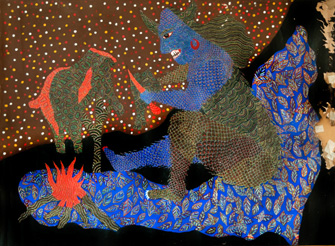 |
|
Duane Hanson’s “Old Couple on a Bench” (1994). Photo: Roy G. Crogan © ADAGP, Paris 2010. |
Even if you are already familiar with Duane Hanson’s hyper-realistic sculptures of ordinary people, that doesn’t mean they won’t still be able to spook you. When you enter …
 |
|
Duane Hanson’s “Old Couple on a Bench” (1994). Photo: Roy G. Crogan © ADAGP, Paris 2010. |
Duane Hanson: Le Rêve Américain
Even if you are already familiar with Duane Hanson’s hyper-realistic sculptures of ordinary people, that doesn’t mean they won’t be able to spook you. When you enter the Pavillon Paul Delouvrier in the Parc de la Villette, where the exhibition “Duane Hanson: The American Dream” is currently showing, it isn’t easy to distinguish the sculptures from the real people looking at them.
Is that museum-weary middle-aged couple on the bench taking a break to rest their aching feet? No, they are not real. As you walk around, you may find yourself apologizing for bumping into someone who turns out to not be anyone, just another of Hanson’s creations. At the opening last week, I looked up and saw a women filming me as I took notes, which made me feel like a Duane Hanson sculpture of a journalist taking notes at an exhibition.
What makes Hanson’s work different from the realistic sculptures in a wax museum? Well, first of all, his subjects are ordinary people, and second, he has a knack for catching people as they really are, with all their blemishes, ordinariness and eccentricities, and in very specific postures, which is what makes them seem so eerily real.
One would think that these statues, dressed in real clothing, would quickly become dated, but the 15 works presented here still look like types you might run into today: tourists, a surfer boy, a fat guy in a T-shirt on his lawnmower, a cleaning lady, etc. In a filmed interview shown in the exhibition, he demonstrates how he made his pieces and talks about his interest in capturing the little things we see every day and portraying people as they are, whether old, tired or fat (his predilections) and with all their faults.
The irony is that these lifelike figures indirectly caused the death of Hanson (1925-96); he was killed by a cancer caused by the materials he used to make his sculptures, synthetic resin and fiberglass.
Parc de la Villette: Pavillon Paul Delouvrier. Métro: Porte de Pantin. Tel.: 01 40 03 75 75. Open Wednesday-Friday and Sunday, 2pm-7pm; Saturday, 2pm-9pm. Free admission. Through August 15, 2010. www.villette.com
Support Paris Update by ordering books about Duane Hanson from Paris Update’s Amazon store at no extra cost. Click on your preferred Amazon location: U.S., France, U.K.
Willy Ronis
 |
|
Willy Ronis’s “Marché aux Puces, 1948.” Photo: Willy Ronis © Ministère de la Culture et de la Communication& Stéphane Kovalsky. |
On my way to the Willy Ronis exhibition at the Monnaie de Paris, I couldn’t help but wonder whether it wasn’t too soon after the show a few years ago at Paris’s Hôtel de Ville to hold another retrospective of the work of this renowned “humanist” photographer, whose pictures are already so well known.
Once inside, however, my doubts evaporated. Although many of the images are familiar, it is always a joy to rediscover them, and many of those on show here are included precisely because they are not well known. So here are the famed, oft-reproduced “Les Amoureux de la Bastille” (1957) and “Le Petit Parisien” (1952), of a little boy running with a baguette, along with a couple of my favorites, including a woman’s legs caught in mid-air as she jumps over the puddle they are reflected in.
Ronis’s photos are full of reflections, as in “Aubervillers” (1950), in which a boy combs his hair in front of a mirror but is looking at the photographer in the mirror rather than his own reflection. The play of glances also figures large in many of these images: in “Rue Xavier-Privas, Paris, 1957,” a boy holding a camera sits on the curb smiling at the photographer, while a man standing in the doorway behind the child looks at him, and a woman in an image in the window looks off to the side. In “Marché aux Puces, Paris, 1948” (pictured above), the central joke is the mannequin’s legs with the sign reading “home for rent,” but plenty of other things are happening as well: another mannequin on the right looks off to the right, while a real man on the left, barely noticeable at first glance, looks intently in the opposite direction at something outside the frame of the photo.
I could go on describing other photos that I loved in this show, but it’s best if you go see for yourself. The exhibition is broken up into five themes: the street, work (notably a series taken in a thread factory), travel (including the Netherlands in the 1950s, when the people in the photos were still dressed in traditional costume), the body (some romantic nudes) and his private life (images of friends). Sadly, Ronis died last year, just before his 100th birthday.
Monnaie de Paris: 11, quai de Conti, 75006 Paris. Métro: Pont Neuf, Saint-Michel or Odéon. Tel.: 01 40 46 56 66. Open Tuesday-Sunday, 11am-7 p.m. (until 9:30pm on Thursday). Admission: €10. Through August 22, 2010. www.monnaiedeparis.fr/musee/
Support Paris Update by ordering books by Willy Ronis from Paris Update’s Amazon store at no extra cost. Click on your preferred Amazon location: U.S., France, U.K.
Autres Maîtres de l’Inde: Créations Contemporaines des Adivasi
 |
|
“Imaginary Creatures” by Jangarh Singh Shyam. Photo © Gireesh G V. |
An unusual exhibition at the Musée du Quai Branly, “Other Masters of India: Contemporary Creations of the Adivasis,” brings together some 400 works that not only spotlight art by the “Adivasis,” or tribal peoples of India, but also illustrate their role in Indian society. Historically poverty-stricken, undereducated and marginalized, the “tribals,” as they are called in India, found new ways of expressing themselves in art after Independence in 1947, when the government gave them paper to make artworks in hopes of giving them a new way to earn a living.
Although rather disjointed – with one section illustrating the way photographers romanticized and sexualized the tribals and another section showing marvelous 19th-century sculptures and other traditional works that set the stage for what is to come – the exhibition offers a wealth of marvelous pieces. For me the most fascinating section, and the real core of the show, is the last part, featuring the work of talented individual artists. The paper they were given freed them from the strictures of ritual painting, which was often done on walls exclusively by women, and allowed them to integrate the modern world into their traditional imagery.
The exhibition ends with one-man shows of the work of 75-year-old Jivya Soma Mashe, who learned to paint as a boy from the women in his village, and the late Jangarh Singh Shyam, the originator of the colorful, graphic “Gond style” of painting, which brings traditional Pardhan Gond religious and folk images into the modern world.
Musée du Quai Branly: 206 or 208, rue de l’Université, or 27, 37 or 51, quai Branly, 75007 Paris. Métro: Alma Marceau. RER: Pont de l’Alma. Tel.: 01 56 61 70 00. Open Tuesday, Wednesday and Sunday, 11 a.m.-7 p.m; Thursday, Friday and Saturday, 11 a.m.- 9 p.m. Admission: €7. Through July 18, 2010. www.quaibranly.fr
Support Paris Update by ordering books on Indian tribal art from Paris Update’s Amazon store at no extra cost. Click on your preferred Amazon location: U.S., France, U.K.
More reviews of Paris art shows.
Reader Reaction: Click here to respond to this article (your response may be published on this page and is subject to editing).
© 2010 Paris Update
Favorite